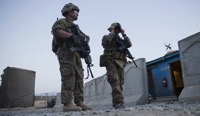
From The Washington Times:
More than a year since the Obama administration officially ended American combat operations in Afghanistan, the White House’s newly minted battle plan for the country effectively restarts the combat mission for the 9,800 U.S. service members still in the country.
White House officials have given the administration’s tacit approval to allow U.S. commanders in Afghanistan to conduct offensive airstrikes against the Taliban and other insurgent groups and to let American troops restart joint ground operations with Afghan forces.
The changes were based on the findings of a three-month review of the situation in Afghanistan, which was overseen by Gen. John Nicholson, the top U.S. commander there, and submitted to Pentagon and White House officials this month.
Before the changes made at Gen. Nicholson’s behest, American air power was authorized only when U.S. forces were under direct threat and American combat missions in the country were limited to special operations teams.
The shift in the White House strategy was a clear recognition that “what is on the ground right now just isn’t working,” said Rick Nelson, a senior counterterrorism analyst at the Center for Strategic and International Studies.
President Obama pledged to end the wars in Iraq and Afghanistan when he announced in 2007 that he was seeking the White House. That campaign promise led to accusations that he was making war decisions based on domestic politics without regard to the situations on the ground.
Mr. Nelson said the White House “has been really bad about changing military tactics” in Afghanistan, pressing ahead with plans to withdraw all U.S. forces from the country by 2017.
The latest move, however, “reflects [that Mr. Obama] is being thoughtful” about what is needed in Afghanistan to ensure the country does not devolve into a failed state, he said.
U.S. military commanders are “still in the process of operationalizing” the strategy, Pentagon spokesman Capt. Jeff Davis told reporters Tuesday.
The changes, he said, would affect only the U.S. military mission in Afghanistan, known as Operation Freedom’s Sentinel, and not the NATO-led training mission under Operation Resolute Support.
The changes approved by the White House did not constitute a return to full-fledged combat by U.S. forces in Afghanistan, Capt. Davis said. Rather, the shift would allow U.S. forces to provide “strategic effects enabling the [Afghan National Security Forces]” to take on the Taliban and other Islamist groups during the fighting season, he said.
U.S. airstrikes, as well as American and Afghan combat missions, would be limited to areas of Afghanistan where local forces need the most help, Capt. Davis said.
The U.S. mission will “not be something where we will be doing this everywhere,” he said.
But in the face of a resurgent Taliban and a floundering Afghan military and police force, U.S. troops may again find themselves engaged in some of the most dangerous areas of Afghanistan, fighting in what has become the longest war in U.S. history.
The White House planned to reduce U.S. troop numbers from the current 9,800 to 5,500 by the end of this year, with the ultimate goal of a full troop withdrawal by the end of next year.
That plan, however, relied heavily on Afghan forces’ ability to hold ground against the Taliban with little to no American military support. But since the official end of U.S. combat operations in the country, the Taliban have stepped up their battle tempo significantly.
After two fighting seasons on their own, Afghan forces have ceded nearly 80 of Afghanistan’s 400-plus districts to Taliban control.
In an April threat assessment on Afghanistan, the Institute for the Study of War, a Washington think tank, warned that Afghan security forces are simply “unprepared to counter the Taliban militants’ summer campaign.”
While the new strategy will depend on U.S. forces to bolster their Afghan counterparts, American commanders do not envision sending additional troops to support that mission, Defense Secretary Ashton Carter said Monday.
“We’re not asking for that at this time,” Mr. Carter told reporters while en route to a NATO ministerial meeting in Brussels.
“That isn’t part of what we’ve talked about with Gen. Nicholson, and we think he can have the effect that he wants to have with the U.S. forces there,” Mr. Carter said.
Hamdullah Mohib, Afghanistan’s ambassador to the U.S., defended his country’s military, noting that its armed forces have made incredible strides amid a constantly evolving enemy.
“The Afghan military was 12 years old in 2015. We’re now fighting an enemy that is more brutal,” Mr. Mohib said during a speech at the Hudson Institute in Washington.
“Once we only faced the Taliban. Now we are attacked by faceless terrorists whose agenda threatens not only Afghanistan, but regional and world security,” he said in reference to Islamic State cells’ reported footholds along his country’s eastern border regions.
Aside from the Islamic State’s efforts in Afghanistan, Gen. Nicholson said, renewed alliances between the Taliban and resurgent al Qaeda terrorist cells in Afghanistan, combined with the Afghan military’s relative ineffectiveness against the militants could force Mr. Obama to abandon his troop withdrawal timeline.
The decision to allow U.S. forces to re-engage in the fight for Afghanistan could be a precursor to that kind of decision, Mr. Nelson suggested.
U.S. and NATO commanders “couldn’t know how good [Afghan forces] would be until we let them go out on their own,” he said.
Given the Afghan performance on the battlefield, U.S. forces now must “re-engage and be more aggressive” in how they operate in the country, Mr. Nelson said, or “everything we have done for the last 15 years goes away. It evaporates.”